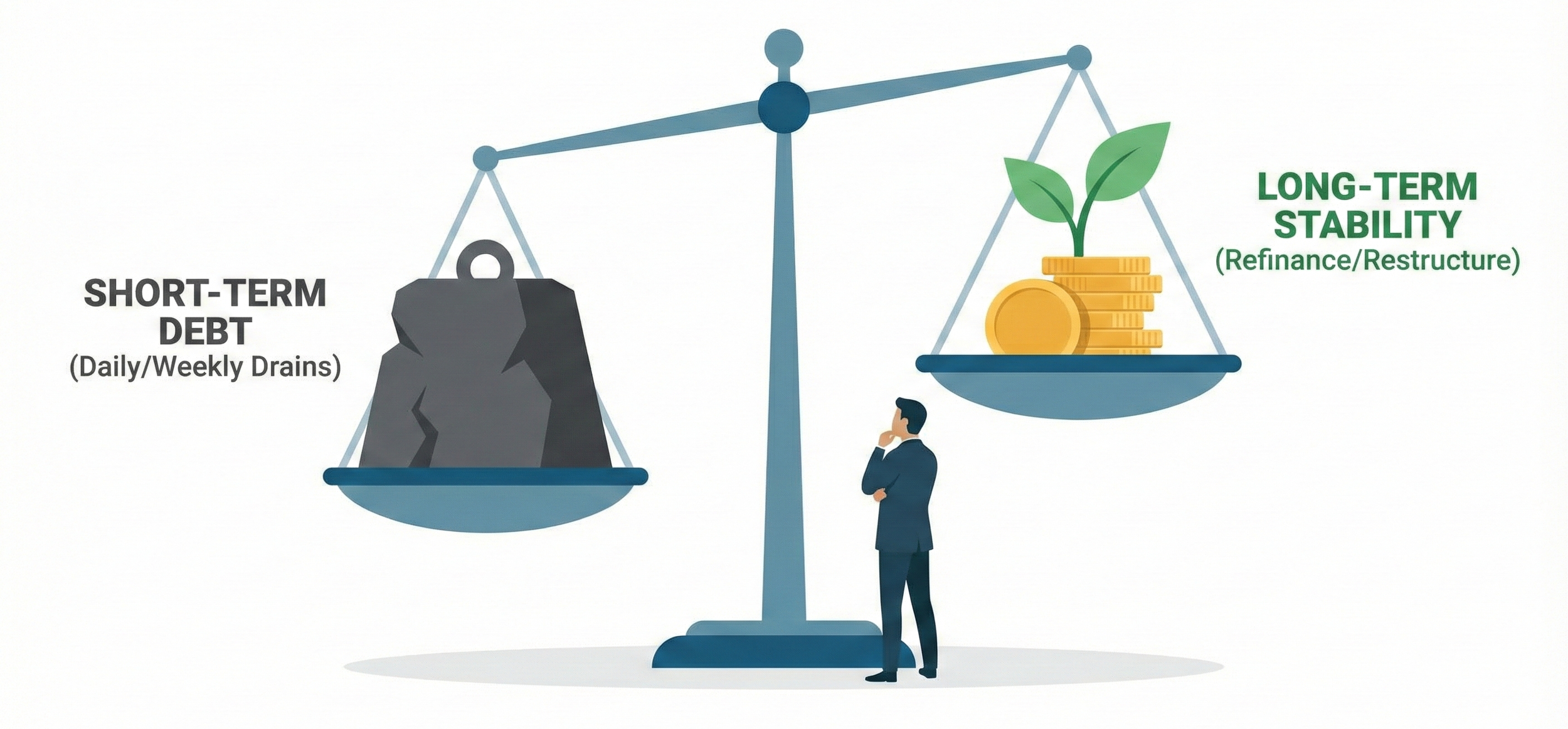General Requirements (takes about 5-minutes or less to apply online)
680+ FICO score (Transunion or Experian FICO model 8.0 or similar)
Less than 15% operating loss in the last year of business
Last 2-Years of filed Business Tax Returns; Last 1-Year of filed Personal Tax Returns
Last 3-months of bank statements; copy of Driver’s License
Business on the Brink:
Understanding Operational Distress
In the heart of every small business owner lies a reservoir of passion, resilience, and an unwavering belief in their vision.
You’ve poured countless hours, immeasurable energy, and significant financial resources into building your enterprise from the ground up.
But what happens when the familiar hum of daily operations begins to sound a discordant note?
When the once-clear path forward becomes shrouded in uncertainty and the very foundation of your business feels unstable?
This is the challenging reality of operational distress, a state that can sneak up on even the most dedicated entrepreneurs, threatening to unravel everything you’ve worked so hard to create.
Understanding operational distress is not about admitting defeat; it’s about recognizing the warning signs early enough to take decisive, corrective action.
It’s about empowering yourself with the knowledge to navigate turbulent waters and steer your business back toward a course of stability and growth.
This article will serve as your comprehensive guide to understanding, identifying, and addressing operational distress.
We will delve into its root causes, illuminate the often-subtle symptoms, and provide a roadmap for recovery.
For the small business owner, this isn't just theoretical knowledge; it's a critical tool for survival and, ultimately, for building a more resilient and enduring enterprise.
The Anatomy of Operational Distress:
What It Is and What It Isn't
Operational distress, at its core, is a condition where a business is unable to effectively and efficiently manage its day-to-day functions, leading to a decline in performance and threatening its long-term viability.
It’s a state of internal turmoil where the processes, systems, and resources that once drove your business forward begin to falter.
This is not merely a bad quarter or a temporary dip in sales.
While financial distress, characterized by cash flow shortages and mounting debt, is a common and often severe symptom, operational distress is the underlying disease.
Think of your business as a complex machine. When it’s running smoothly, all the gears mesh, the engine purrs, and the output is consistent and high-quality.
Operational distress is when those gears start to grind.
It’s the breakdown in the internal mechanics of your business. This could manifest as production delays, a decline in product or service quality, plummeting employee morale, or an inability to keep up with customer demand.
It's crucial to distinguish operational distress from external market shifts.
A new competitor, a change in consumer trends, or an economic downturn are external pressures.
While these can certainly trigger or exacerbate internal problems, operational distress refers to the company's inability to adapt and respond to these pressures effectively.
A healthy, operationally sound business can pivot, innovate, and weather external storms.
A business in operational distress, however, will likely find itself struggling to stay afloat.
Recognizing this distinction is the first step toward a correct diagnosis and an effective treatment plan.
The Telltale Signs:
Recognizing the Early Warnings of Distress
The insidious nature of operational distress is that its onset is often gradual.
The warning signs can be subtle at first, easily dismissed as isolated incidents or temporary setbacks.
However, for the discerning business owner, these early indicators are crucial signals that demand attention.
Ignoring them is akin to ignoring a persistent cough that could signal a more serious underlying illness.
One of the most immediate and telling signs is a consistent decline in product or service quality.
Are customer complaints on the rise? Are you experiencing an increase in product returns or warranty claims?
This often points to breakdowns in your production processes, a lack of quality control, or issues with your supply chain.
Another critical indicator is a noticeable drop in employee morale and a corresponding increase in turnover.
Your team is on the front lines, and their engagement and satisfaction are a direct reflection of the health of your internal operations.
When good employees start leaving,
it's often a sign of deeper systemic problems.
Pay close attention to your key performance indicators (KPIs).
Are you consistently missing production targets?
Is your customer acquisition cost soaring while customer lifetime value plummets?
Are your inventory levels perpetually imbalanced, with too much of what you don't need and not enough of what you do?
These metrics are the vital signs of your business, and a sustained negative trend is a clear red flag.
Furthermore, an over-reliance on a few key employees to "fight fires" and keep things running is a dangerous sign of fragile and unsustainable processes.
Unearthing the Roots:
Common Causes of Operational Breakdown
Operational distress rarely stems from a single, isolated event.
More often, it’s the result of a confluence of factors that, over time, erode the operational integrity of the business.
Understanding these root causes is essential for developing a targeted and effective recovery strategy.
A primary culprit is often a lack of clear and effective leadership.
When a business lacks a cohesive vision, clear communication, and decisive decision-making at the top, the entire organization can drift into a state of confusion and inefficiency.
This can manifest as conflicting priorities, a lack of accountability, and a failure to adapt to changing market conditions.
Inadequate or outdated systems and processes are another major contributor.
Many small businesses, in their early stages, rely on ad-hoc or informal processes.
As the business grows, these "duct-taped" solutions can no longer support the increased complexity and volume of operations.
A failure to invest in scalable systems for everything from inventory management and financial tracking to customer relationship management can lead to significant bottlenecks and errors.
A dysfunctional company culture can also be a potent source of operational distress.
A culture that stifles innovation, discourages open communication, and fails to empower employees will invariably lead to a disengaged and unproductive workforce.
This can result in a lack of ownership, a resistance to change, and a general decline in the quality of work.
Finally, a failure to anticipate and plan for growth can be a business's undoing. Rapid, uncontrolled growth can strain resources, overwhelm existing processes, and lead to a catastrophic breakdown in operations.
The Domino Effect:
The Far-Reaching Consequences of Inaction
Ignoring the warning signs of operational distress is a gamble that no small business owner can afford to take.
The consequences of inaction are not linear; they are exponential, creating a domino effect that can quickly escalate from manageable problems to an existential crisis for your business.
The most immediate and tangible consequence is, of course, financial.
Operational inefficiencies directly impact your bottom line.
Increased waste, rework, and shipping delays drive up costs.
Declining quality and poor customer service lead to lost sales and a shrinking customer base.
This toxic combination can quickly deplete your cash reserves, making it difficult to pay suppliers, meet payroll, and invest in necessary improvements.
Beyond the financial impact, operational distress wreaks havoc on your company’s reputation.
In today's hyper-connected world, news of poor quality, unreliable service, and unhappy customers travels fast.
A damaged reputation can be incredibly difficult to repair and can have long-lasting effects on your ability to attract new customers and retain existing ones.
The internal consequences are equally devastating.
Sustained operational distress creates a high-stress, chaotic work environment.
Employee morale plummets, leading to decreased productivity, increased absenteeism, and a mass exodus of your most talented and experienced team members.
This brain drain further exacerbates the operational problems, creating a vicious cycle of decline.
Ultimately, if left unaddressed, operational distress can lead to the complete failure of the business, resulting in the loss of your investment, your livelihood, and the dream you worked so tirelessly to build.
A Mirror to Your Business:
Conducting an Honest Operational Assessment
Once you’ve acknowledged the possibility of operational distress, the next critical step is to conduct a thorough and brutally honest assessment of your business.
This is not the time for ego or wishful thinking.
It’s a time for a clear-eyed examination of every facet of your operations to identify the specific areas of weakness and the root causes of the problems.
Begin by mapping out your key operational processes from end to end.
Follow the journey of your product or service from the initial customer inquiry to the final delivery and follow-up.
Where are the bottlenecks? Where are the communication breakdowns?
Where are the opportunities for error or delay? Talk to your employees at every level.
They are an invaluable source of information and often have a keen understanding of what is and isn’t working on the front lines.
Dive deep into your financial data. Analyze your profit and loss statements, your cash flow statements, and your balance sheets.
Look for trends in your margins, your costs, and your debt levels.
Are your costs increasing disproportionately to your revenue? Is your cash flow consistently negative?
This financial analysis will provide a quantitative measure of the impact of your operational issues.
Benchmark your performance against industry standards and your direct competitors.
How does your production efficiency, customer satisfaction, and employee turnover rate compare?
This will give you an objective measure of your performance and highlight areas where you are falling behind.
Finally, solicit feedback from your customers.
Conduct surveys, read online reviews, and have direct conversations to understand their perceptions of your products, services, and overall customer experience.
This external perspective is invaluable in identifying your operational blind spots.
General Requirements (takes about 5-minutes or less to apply online)
680+ FICO score (Transunion or Experian FICO model 8.0 or similar)
Less than 15% operating loss in the last year of business
Last 2-Years of filed Business Tax Returns; Last 1-Year of filed Personal Tax Returns
Last 3-months of bank statements; copy of Driver’s License
Charting a New Course:
Developing a Strategic Recovery Plan
An honest assessment will likely reveal a number of challenging truths about your business.
But with this clarity comes the power to effect meaningful change.
The next step is to translate your findings into a strategic recovery plan (Restructuring or Reorganization Plan).
This plan will be your roadmap out of distress and back to a state of operational health and stability.
Your recovery plan should be built around clear, measurable, and achievable goals.
Prioritize the most critical issues that are having the biggest impact on your business.
This might be stabilizing your cash flow, improving product quality, or streamlining a key production process.
For each goal, define specific, actionable steps that you will take to achieve it.
Assign responsibility for each action to a specific individual or team and set a clear timeline for completion.
Your plan must also include a detailed financial forecast.
This will help you to understand the financial implications of your recovery efforts and to ensure that you have the necessary resources to see them through.
Be realistic in your projections and build in contingencies for unexpected challenges.
Communication is paramount during this process.
Share your recovery plan with your key stakeholders, including your employees, your lenders, and your most important suppliers.
Be transparent about the challenges you are facing and the steps you are taking to address them.
This will help to build trust and to secure their support and cooperation.
A well-conceived and effectively communicated recovery plan can be a powerful tool for galvanizing your team and rebuilding momentum.
The Turnaround Toolkit:
Proven Strategies for Operational Renewal
With a strategic recovery plan in hand, it’s time to roll up your sleeves and begin the hard work of implementation. There are a number of proven turnaround strategies that can be highly effective in addressing the root causes of operational distress and fostering a sustainable recovery.
One of the most powerful strategies is the adoption of lean principles.
Lean is a systematic approach to eliminating waste and maximizing value in your operations.
This involves identifying and eliminating any activity that does not add value from the customer’s perspective.
This could include reducing excess inventory, eliminating unnecessary steps in your processes, and empowering your employees to identify and solve problems.
Investing in technology can also be a game-changer.
Modern software solutions for everything from project management and accounting to customer relationship management can automate manual tasks, improve communication, and provide you with real-time data to make better-informed decisions.
While there may be an upfront cost, the long-term gains in efficiency and effectiveness can be substantial.
Don’t be afraid to restructure your organization if necessary.
This might involve redefining roles and responsibilities, creating new teams, or even making the difficult decision to let go of employees who are not a good fit for the future direction of your business.
A well-designed organizational structure can improve communication, clarify accountability, and foster a more collaborative and productive work environment.
Finally, focus on rebuilding a positive and high-performing company culture.
This involves creating a work environment where employees feel valued, empowered, and motivated to do their best work.
Seeking Guidance:
The Invaluable Role of Professional Advisors
As a small business owner, it’s easy to feel like you have to have all the answers.
But when you’re facing a challenge as significant as operational distress, trying to go it alone can be a recipe for disaster.
Seeking the guidance of experienced professional advisors is not a sign of weakness; it’s a sign of strategic leadership.
A turnaround ADVISOR can bring a fresh, objective perspective to your business.
They have the experience of having seen and solved similar problems in a variety of industries.
They can help you to conduct a thorough assessment, develop a robust recovery plan, and guide you through the implementation process.
Their expertise can be invaluable in helping you to avoid common pitfalls and to accelerate your path to recovery.
A skilled financial advisor can help you to stabilize your finances, renegotiate with creditors, and secure the financing you need to fund your turnaround efforts.
They can also help you to develop a more robust financial management system to ensure the long-term financial health of your business.
Legal counsel is also essential, particularly if you are facing significant debt, potential litigation, or the need to restructure your business.
An experienced business attorney can help you to navigate the legal complexities of your situation and to protect your personal and business assets.
The investment in professional advice can pay for itself many times over in the form of a successful turnaround and a more resilient and profitable business.
Fortifying the Foundation:
Preventing a Relapse into Distress
Successfully navigating a period of operational distress is a monumental achievement.
But the work doesn’t stop there.
The final and perhaps most important step is to take the lessons you’ve learned and use them to fortify the foundation of your business to prevent a relapse into distress in the future.
This begins with a commitment to continuous improvement.
The business world is constantly evolving, and your operations must evolve with it.
Regularly review and refine your processes, invest in ongoing training for your employees, and stay abreast of new technologies and industry best practices.
Create a culture where everyone in your organization is constantly looking for ways to do things better.
Develop a robust system of key performance indicators (KPIs) and review them on a regular basis.
These metrics will serve as your early warning system, allowing you to spot potential problems before they escalate into full-blown crises.
Establish clear lines of communication and accountability throughout your organization.
Ensure that everyone understands their role and how their work contributes to the overall success of the business.
Build a strong and resilient company culture.
Foster an environment of open communication, trust, and mutual respect.
Empower your employees to take ownership of their work and to contribute their ideas for improvement.
A highly engaged and motivated workforce is your best defense against operational distress.
Finally, never stop learning.
As a business owner, your own growth and development are essential to the long-term success of your enterprise.
The Resilient Entrepreneur:
Embracing the Lessons of Adversity
The journey through operational distress is undoubtedly one of the most challenging experiences a small business owner can face.
It will test your resolve, your ingenuity, and your emotional fortitude.
However, it is also an opportunity for profound growth and transformation.
By confronting the challenges head-on, by making the tough decisions, and by embracing the lessons of adversity, you can emerge from the crucible of distress not just as a survivor, but as a more resilient, more strategic, and more effective leader.
Your business, in turn, will be stronger, more efficient, and better equipped to thrive in the ever-changing landscape of the modern economy.
The path to recovery may be arduous, but the rewards of building a truly resilient and enduring enterprise are immeasurable.
WHAT IS THE BEST AND SAFEST WAY FOR YOUR BUSINESS TO DEAL WITH HIGH BUSINESS DEBT PAYMENTS?
It is NOT by stopping ACH payments.
It is NOT by taking on another business loan.
It is NOT ALWAYS a Refinancing
It is NOT by entering into a debt settlement program.
Find out the BEST strategies to get your Business back to where it was



















